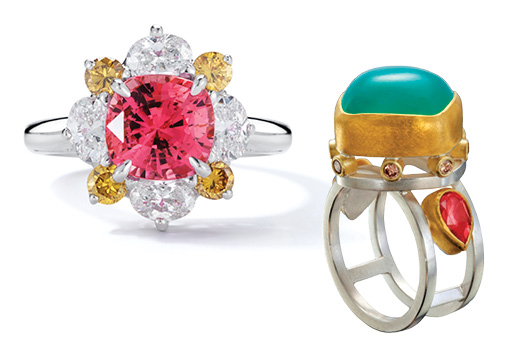
While all eyes were on Meghan Markle as she completed her ascent to the British aristocracy in May, there has been another member of the royal family whose engagement ring has caused ripples in the jewelry world. Princess Eugenie’s padparadscha sapphire ring not only affirmed the acceptance of colored gemstones in bridal jewels, it also introduced this incredibly rare hue of sapphire to the wider public.
“Princess Eugenie’s engagement has definitely had an effect on the growing padparadscha trend,” agrees Niveet Nagpal, head designer and president at Omi Privé and Omi Gems, which have long championed this stone. “Named after the lotus flower blossom of Sri Lanka, the orangey-pink padparadscha sapphire is a favorite of ours and is highly coveted amongst colored-gemstone connoisseurs. These special sapphires are rare in their optimal color and typically demand a hefty premium over fancy pink or orange sapphires.”
The optimal balance of orange and pink remains up for debate in gem circles, as does the relevance of a stone’s origin. “Historically, padparadscha sapphires are found in Sri Lanka, and many connoisseurs still insist that only a padparadscha from Sri Lanka is a true padparadscha,” says Nagpal, although Omi Gems also works with padparadschas from Madagascar and Mozambique. “Supply of padparadscha is always a challenge — now more than ever, since people are familiar with the stone.”
Tom Heyman, principal at jeweler Oscar Heyman, has seen an uptick in inquiries, especially since Princess Eugenie’s engagement. However, he believes supply difficulties will keep the gem out of the mainstream. “I don’t think that the supply and availability of padparadschas will ever be large enough to raise the quantity of sales to the level of popular,” says Heyman, a padparadscha purist. “We have a necklace with 45 no-heat [Sri Lankan] padparadschas that took years to collect.”
Indeed, some jewelers have noted a rise in more accessible gems, such as morganites, that capture a similar pinkish hue, as a direct result of increased padparadscha interest.
At auction, padparadschas remain an oddity — and are rarely larger than 10 carats — but when they do appear, they sell well. Last month, Christie’s auctioned off an 18-carat orangey-pink Ceylon sapphire that the GIA certified as an unheated padparadscha. The stone, which was set in an unusual blackened platinum ring with black diamonds, had a low pre-sale estimate of $300,000 but sold for nearly $700,000.
“[Padparadscha] prices are normally high,” says Christie’s senior international jewelry director David Warren. “These stones are always very speculative, and it depends so much on the beauty of the blend of pink and orange that characterizes these remarkable stones. We often find that our pre-sale estimates are left far behind as the better examples are fought over by gem connoisseurs from around the world.”
And jewelers, too. While supply and pricing make dedicated collections rare, these gems are increasingly popping up in designs across the market, from independent makers like Olivia Ewing to international players like Chaumet, and while padparadschas might take a long time to source, the sale is usually swift.
Image (left to right): Oscar Heyman ring; Sam Woehrmann Aquaprase ring.Article from the Rapaport Magazine - June 2018. To subscribe click here.